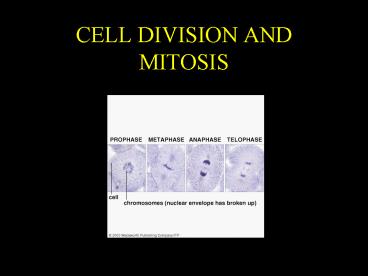CELL DIVISION AND MITOSIS - PowerPoint PPT Presentation
1 / 28
Title:
CELL DIVISION AND MITOSIS
Description:
CELL DIVISION AND MITOSIS. I. Cell Division - the process ... A. Animal cells - contractile ring of microfilaments. tightens to form a form a cleavage furrow ... – PowerPoint PPT presentation
Number of Views:51
Avg rating:3.0/5.0
Title: CELL DIVISION AND MITOSIS
1
CELL DIVISION AND MITOSIS
2
I. Cell Division - the process whereby cells
generate new copies of themselves
A. Unicellular organisms - means of
reproduction
B. Multicellular organisms
1.Basis of producing new body cells
(growth and maintenance)
2. Production of cells for reproduction
C. Overall process cells duplicate their DNA
and divide it between two daughter cells
3
II. Cell Division in Prokaryotes
A. Bacterial chromosome - genetic
information is carried on a single
circular chromosome
4
B. Cell divides by prokaryotic fission
5
III. Cell Division in Eukaryotes
A. Chromosomes - rod-shaped structures
that form when a single DNA
molecule and associated proteins
coil before cell division
B. Packing DNA into chromosomes
6
1. Histones - positively charged proteins that
fold and bundle the DNA
2. DNA is wound around a complex of histones to
make up units called nucleosomes
3. Nucleosomes - basic packaging units of
chromosomes
One nucleosome
DNA
DNA
histone core
Figure 9.3
Fig. 9.9, p. 156-157
7
C. Chromosomes duplicate prior to cell division
1. Composed of two sister chromatids
attached at centromere
8
2. Sister chromatids separate during cell division
9
IV. The Cell Cycle
Figure 9.4
A. Interphase - 90 of cell cycle
1. G1 (Growth 1) - time of
growth just after division
2. S (Synthesis) - replication
of DNA
3. G2 (Growth 2) -
additional growth and preparation for
division
10
B. Mitotic phase
1. Mitosis - division of the cell
nucleus into two daughter nuclei
2. Cytokinesis - dividing of the
cytoplasm
11
V. Stages of Mitosis
A. Consists of four continuous phases
Interphase
Metaphase
Prophase
Telophase
Anaphase
12
B. Cell at interphase - DNA replicates in
preparation for cell division
nucleus
centrioles
13
Early Prophase
CELL AT INTERPHASE
EARLY PROPHASE
LATE PROPHASE
PROMETAPHASE
C. Mitosis in animal cells
1. Early prophase - chromosomes become
visible and condense
pair of
Fig. 9.5a, p. 152
14
Late Prophase
CELL AT INTERPHASE
EARLY PROPHASE
LATE PROPHASE
PROMETAPHASE
2. Late prophase
a. Centrioles direct formation of the
mitotic spindle b. Aster extend from
centrioles c. Nuclear envelope breaks
down
pair of
Fig. 9.5a, p. 152
15
Transition to Metaphase
CELL AT INTERPHASE
EARLY PROPHASE
LATE PROPHASE
PROMETAPHASE
3. Transition to metaphase - chromosomes become
attached to the mitotic spindle
pair of
Fig. 9.5a, p. 152
16
METAPHASE
ANAPHASE
TELOPHASE
INTERPHASE
Metaphase
4. Metaphase - chromosomes align at the spindle
equator
Fig. 9.5b, p. 153
17
METAPHASE
ANAPHASE
TELOPHASE
INTERPHASE
Anaphase
5. Anaphase - chromatids separate and move toward
spindle poles
Fig. 9.5b, p. 153
18
Telophase
METAPHASE
ANAPHASE
TELOPHASE
INTERPHASE
6. Telophase
a. Nuclear envelopes form around daughter
chromosmes b. Chromosomes revert to chromatin
Fig. 9.5b, p. 153
19
METAPHASE
ANAPHASE
TEOPHASE
INTERPHASE
Two daughter cells in interphase
7. Daughter cells are identical to each other
and to the parent cell from which they
formed
Fig. 9.5b, p. 153
20
D. Spindle apparatus - moves the chromosomes
1. Composed of two sets of microtubules
2. Moves sister chromatids to opposite spindle
poles
21
3. Kinetochore - protein disk where the spindle
attaches to the centromere
22
E. Separation of sister chromosomes during
anaphase
1. Kinetochore microtubules shorten
2. Polar microtubules move apart
23
VI. Cytokinesis - division of the cytoplasm
A. Animal cells - contractile ring of
microfilaments tightens to form a
form a cleavage furrow
24
cell wall
former spindle equator
light formation in a dividing plant cell
vesicles converging
cell plate
B. Plant cells - cell plate forms between
daughter cells
Fig. 9.6, p. 154
25
VII. Cancer - a Mistake in the Cell Cycle
A. Cancer - uncontrolled cell division
resulting in a tumor
1. Benign tumor - a abnormal mass of
otherwise normal cells
2. Malignant tumor - capable of metastisis
(spreading into neighboring tissues or
other parts of the body
26
(No Transcript)
27
B. Cancers are named according to the tissue in
which they arise
1. Carcinomas - arise in epithelial tissues
of skin, glands, and membranes
2. Sarcomas - arise in supporting and
connecting tissues, such as bone or muscle
3. Leukemias - arise in blood forming tissues
such as bone marrow
4. Lymphomas - arise in lymphatic tissue
28
C. Cancer treatment
1. Radiation therapy - disrupts the
process of cell division
2. Chemotherapy - involves drugs that
disrupt cell division (taxol,
vinblastin)































